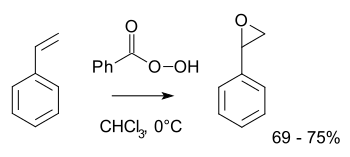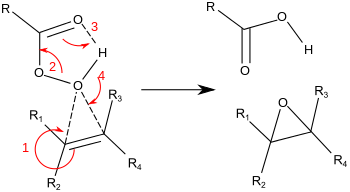Prilezhaev reaction
| Prilezhaev reaction | |
|---|---|
| Named after | Nikolaus Prileschajew |
| Reaction type | Ring forming reaction |
| Identifiers | |
| Organic Chemistry Portal | prilezhaev-reaction |
| RSC ontology ID | RXNO:0000405 |
The Prilezhaev reaction, also known as the Prileschajew reaction or Prilezhaev epoxidation, is the chemical reaction of an alkene with a peroxy acid to form epoxides.[1] It is named after Nikolaus Prileschajew, who first reported this reaction in 1909. The most widely used peroxy acid for oxidation of the alkene is m-CPBA, due to its stability and good solubility in most organic solvents.[2] An illustrative example is the epoxidation of styrene with perbenzoic acid to styrene oxide:[3]

Reaction mechanism
The reaction proceeds via what is commonly known as the "Butterfly Mechanism" where the peracid is intramolecularly hydrogen bonded.[4] The peroxide is viewed as an electrophile, and the alkene as a nucleophile. The reaction is considered to be concerted (the numbers in the mechanism below are for simplification). The butterfly mechanism allows ideal positioning of the O-O sigma star orbital for C-C Pi electrons to attack.[5]

There is a very large dependence of the reaction rate on the choice of solvent.[6]
References
- ↑ Nikolaus Prileschajew (1909). "Oxydation ungesättigter Verbindungen mittels organischer Superoxyde". Berichte der deutschen chemischen Gesellschaft. 42 (4): 4811–4815. doi:10.1002/cber.190904204100.
- ↑ László Kürti & Barbara Czakó (2005). Strategic Applications of Named Reactions in Organic Synthesis: Background and Detailed Mechanisms. Elsevier Academic Press. p. 362. ISBN 0124297854.
- ↑ Harold Hibbert; Pauline Burt (1941). "Styrene Oxide". Organic Syntheses. ; Collective Volume, 1, p. 494
- ↑ Paul D. Bartlett (1950). "Recent work on the mechanisms of peroxide reactions". Record of Chemical Progress. 11: 47–51.
- ↑ John O. Edwards (1962). Peroxide Reaction Mechanisms. Interscience, New York. pp. 67–106.
- ↑ Dryuk, V.G. (January 1976). "The mechanism of epoxidation of olefins by peracids". Tetrahedron. 32 (23): 2855–2866. doi:10.1016/0040-4020(76)80137-8.